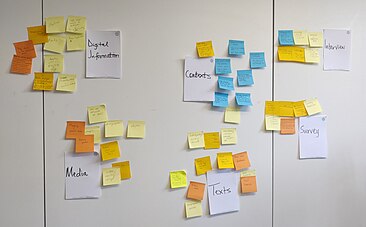Inclusive Data Research Skills for Arts and Humanities/What counts as data?

In an arts and humanities context, what counts as data can be any observable traces of interactions and occurrences. In arts and humanities research, any of a vast and complex set of recordable observations and artifacts fit into some definition of “data”, and the contextual issues around their interpretation depend on the form of data that is being dealt with. The following page is an attempt to provide broad categorisations and distinctions between different kinds of data, and address some of the challenges in their use.
The absence of data also constitutes data (was something destroyed or lost, is something disregarded or in a foreign language or physically/digitally inaccessible, etc.).
Potential Categorisations
[edit | edit source]Data categorisations are influenced by a variety of factors including research objectives, research questions, research design, existing standards within a specific discipline, approaches to information interpretation, nature of sources of information, and psychological connotations, among others. How researchers collect data also plays an important role in how this data is then perceived, categorised and analysed.
Qualitative and quantitative data
[edit | edit source]Researchers’ objectives determine the methods used and approach to data. Depending on the aims of the research and research questions, data could fit into qualitative and quantitative categories. For example, surveys can provide both qualitative and quantitative data depending: what % of people answered yes or no to certain questions? OR describe, interpret and contextualise each response.
Qualitative
[edit | edit source]- Oral histories and interviews
- Archival text
- Artwork and media objects
- Free text responses to surveys
Quantitative
[edit | edit source]- Website analytics
- Census records
- Datasets
Analogue and digital data
[edit | edit source]The nature of the sources of data determines if we can classify data as analogue (physical) or digital.
Analogue Data - Trace of interaction with the surrounding world through time.
Research objectives and questions also influence the classification of data as analogue or digital. For instance, a book historian analysing a digitised version of a manuscript would consider it to be a source of analogue/physical data, while a researcher analysing the level of digitisation of a collection would most likely consider it to be a digital source.
Analogue/physical:
[edit | edit source]- artworks/objects,
- books,
- manuscripts,
- documents,
- photographs,
- slides,
- Negatives,
- Maps
- Desire paths
Digital data:
[edit | edit source]- Website analytics
- Digital scans of physical/analogue items
- Videography
- Films / documentaries
- Digital files of photographs
- Comments from social media
- E-books
- Voice records
- Datasets
- Online / app usage
Subjective and objective data
[edit | edit source]Subjective
[edit | edit source]- Autoethnographic data
- Opinions / perspectives
- Diaries
- Cultural background differences
- Physical ability
- Experiential data
Objective
[edit | edit source]- Census records (for certain demographics and when answering specific questions within traditional, pre-existing societal categories)
- Materials, ie that constitute an artwork
- Chemical analysis, X-ray, etc.
Data Resources
[edit | edit source]Datasets
[edit | edit source]- Kaggle.com
- Google.com
- Kanopy.com
- The British Library
- Museums
- Office for National Statistics
- Government data (from data.gov.uk)
- People (through interviews/surveys)
- Office for National Statistics
- Police Data
- UK Data Service
Online archives
[edit | edit source]- Bishopsgate Institute
- New York Public Library
- Discover Europe’s digital cultural heritage | Europeana
- Images search | Wellcome Collection
- Courtauld Gallery Online Collections
- Social-networking photo sharing platforms like Instagram, Facebook, Twitter etc.
- The Met Museum